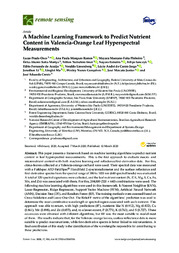A machine learning framework to predict nutrient content in valencia-orange leaf hyperspectral measurements.
A machine learning framework to predict nutrient content in valencia-orange leaf hyperspectral measurements.
Author(s): OSCO, L. P.; RAMOS, A. P. M.; PINHEIRO, M. M. F.; MORIYA, E. A. S.; IMAI, N. N.; ESTRABIS, N.; IANCZYK, F.; ARAÚJO, F. F.; LIESENBERG, V.; JORGE, L. A. de C.; LI, J.; MA, L.; GONÇALVES, W. N.; MARCATO JUNIOR, J.; CRESTE, J. E.
Summary: This paper presents a framework based on machine learning algorithms to predict nutrient content in leaf hyperspectral measurements. This is the first approach to evaluate macro- and micronutrient content with both machine learning and reflectance/first-derivative data. For this, citrus-leaves collected at a Valencia-orange orchard were used. Their spectral data was measured with a Fieldspec ASD FieldSpec® HandHeld 2 spectroradiometer and the surface reflectance and first-derivative spectra from the spectral range of 380 to 1020 nm (640 spectral bands) was evaluated.A total of 320 spectral signatures were collected, and the leaf-nutrient content (N, P, K, Mg, S, Cu, Fe, Mn, and Zn) was associated with them. For this, 204,800 (320 × 640) combinations were used. The following machine learning algorithms were used in this framework: k-Nearest Neighbor (kNN), Lasso Regression, Ridge Regression, Support Vector Machine (SVM), Artificial Neural Network (ANN), Decision Tree (DT), and Random Forest (RF). The training methods were assessed based on Cross-Validation and Leave-One-Out. The Relief-F metric of the algorithms’ prediction was used to determine the most contributive wavelength or spectral region associated with each nutrient. This approach was able to return, with high predictions (R2), nutrients like N (0.912), Mg (0.832), Cu (0.861), Mn (0.898), and Zn (0.855), and, to a lesser extent, P (0.771), K (0.763), and S (0.727). These accuracies were obtained with different algorithms, but RF was the most suitable to model most of them. The results indicate that, for the Valencia-orange leaves, surface reflectance data is more suitable to predict macronutrients, while first-derivative spectra is better linked to micronutrients. A final contribution of this study is the identification of the wavelengths responsible for contributing to these predictions.
Publication year: 2020
Types of publication: Journal article
Unit: Embrapa Instrumentation
Keywords: Macronutrient, Micronutrient, Proximal sensor
Observation
Some of Embrapa's publications are published as ePub files. To read them, use or download one of the following free software options to your computer or mobile device. Android: Google Play Books; IOS: iBooks; Windows and Linux: Calibre.
Access other publications
Access the Agricultural Research Database (BDPA) to consult Embrapa's full library collection and records.
Visit Embrapa Bookstore to purchase books and other publications sold by Embrapa.

